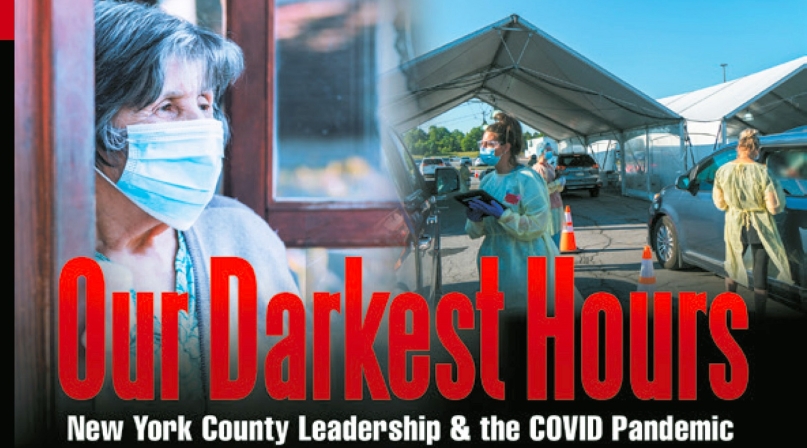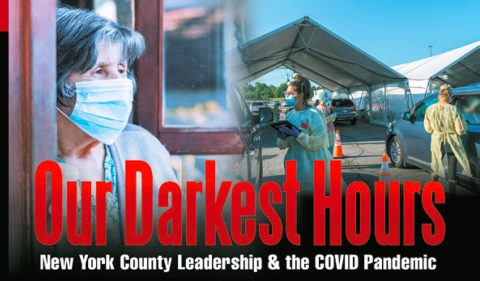Book except: Our Darkest Hours
Upcoming Events
Related News

County executives Marcus Molinaro (Dutchess County, N.Y.) and Dan McCoy (Albany County, N.Y.) recently announced the release of Our Darkest Hours, a new book that chronicles the county response through the first year of the COVID-19 pandemic. The book was commissioned by the New York State County Executives Association (NYSCEA) to document and share the hard lessons learned during this once-in-a-century public health crisis.
Part I of the book comes directly from the written or oral histories submitted by county executives to document what happened in their county. These riveting first-person accounts provide a glimpse into the fear, struggle, triumph and pain that local leaders faced as they worked to protect their residents from an invisible and insidious enemy.
“The work that we did to stop the spread of the virus and get our communities vaccinated may be the most important work we ever do as county leaders,” said NYSCEA President Marcus Molinaro. “We felt that we owed it to the county leaders who come after us to provide an accurate and unvarnished account of what happened so that when it’s their turn to step up as onsite incident commanders, they don’t have to re-learn the same hard lessons that many of us did.”
If you are attending the NACo Annual Conference, attendees are invited to a Q&A with County News and NYSAC Executive Director Stephen Acquario, Sunday, July 11, 3:45-5 p.m. Attendees will receive a free copy of the book. Below is an excerpt from the book:
Lessons Learned from COVID-19 — A National Overview
by Matt Chase, executive director, NACo
From the beginning, county officials and employees have worked tirelessly on the front lines of the COVID-19 pandemic, in communities large and small, to preserve both the lives of our residents and our way of life.
Starting with the Great Recession, the number of county and city public health jobs decreased by more than a quarter between 2008 and 2020, losing more than twenty-five thousand positions in one thousand nine hundred forty-three local government public health agencies. Large public health departments saw nearly a one-third drop in their budgets over that time, and small county health departments experienced about a 10 percent decrease. This loss of funding has forced public health departments to shift their approach, reacting rather than anticipating threats and planning for them.
As a nation, we fund our health responses on a crisis-by-crisis basis—for H1N1 or Zika or Ebola or HIV/AIDS or opioids. This shortsighted pattern starved our public health functions. Thus, when a global pandemic like COVID-19 hits, it is no surprise the country isn’t prepared. In fact, we were so unprepared that nine months after COVID-19 was detected here, there would only be two sparsely populated rural counties that did not register positive test results.
Sounding the Alarm
NACo started tracking the coronavirus early in 2020. San Diego County, California, was the first to take action, on February 14, when it declared a public health emergency so it could access state and federal funds to combat the spread of the virus. At the time, San Diego County was taking in U.S. overseas military personnel and family members from China, and the concern was that many of those individuals could be carrying COVID-19.
That was happening as NACo was adjusting the agenda for our 2020 Legislative Conference in Washington, D.C. We changed our programming and media tour to stress the danger posed by the virus. At a time when the national media was focused mainly on China, Europe, Washington state, California, and New York, it was essential to put counties across the nation on alert because we believed the virus would soon be moving inland from the coasts.
Dr. Robert Redfield, director of the Centers for Disease Control and Prevention, and CDC Chief Medical Officer Mitch Wolfe spoke to county officials, along with President Trump, at the NACo conference. Afterward, attendees headed home, and within a week were starting to take protective measures to slow the spread of the virus.
This was going to test counties in new, dramatic ways. Of course, preserving the lives and health of residents took precedence. Yet it was apparent that the economic consequences of life-saving measures would strain county budgets and reduce basic services. Counties were already funding human services to the tune of $58 billion annually before the pandemic, but soon we would be stacking responsibilities higher on a narrower tax base.
Financial Stability
As counties worked to save as many lives as possible, the federal and state governments worked to provide us with the resources we needed to accomplish the job.
Early on, Congress and the White House worked well together to pass a series of stimulus bills to help stabilize the economy. Congress also appropriated $500 billion for the U.S. Treasury and the Federal Reserve to create the Municipal Lending Facility (MLF), giving state and local governments access to credit when other financing routes were blocked by the chaos in traditional financial markets. The MLF served as a backstop lender for the municipal bond market, which funds up to 80 percent of the nation’s public infrastructure. That was a necessary move because investors had pulled $41 billion from that market in just a few days. Before the MLF was established, borrowing costs for local governments increased by up to 2.25 percent, and anyone who had a variable interest rate on their municipal bonds was facing dramatic increases.
The MLF and the financing opportunities it allowed for counties with populations of more than five hundred thousand was one of the most important actions the federal government took. It restored the confidence of the private markets that state and local governments and special purpose districts are still a sound investment. That not only was a lifeline to county governments, but it also calmed a jittery bond market.
A Little Help Here
That’s not to overlook the impact of the overall Coronavirus Aid, Relief and Economic Security Act—the CARES Act. The $2.2 trillion stimulus package included the $150 billion Coronavirus Relief Fund, which supplied local governments with additional resources to pay for costs associated with fighting the pandemic. With direct payments to large counties and optional suballocations to smaller counties through state governments, counties had funding to purchase personal protective equipment, pay for social distancing measures to be installed in county facilities, and allow counties to make their own decisions about how to support our communities.
As general understanding increased around the nature of the virus’s contagion, counties worked to secure non congregate housing not just for residents who needed a safe place to quarantine, but also shelter for unhoused residents who would otherwise be living in close quarters.
With extended closures to nonessential businesses adding up, counties provided services to out-of-work residents. Rental and utility assistance kept people in their homes, grants to small businesses kept the lights on, and local versions of the Paycheck Protection Program allowed businesses to pay their workers. Counties also lent a hand to the municipalities within their borders.
Some counties planned relief fund distributions with the impact of the virus in mind, directing funds to women- and minority-owned small businesses. Counties provided relief for struggling families with food procurement programs and also funded existing food banks.
As people stayed home, economic challenges, isolation, and psychological strains mounted. Counties saw increased demands on mental health, substance abuse, and domestic violence programs. Social service practitioners developed new service delivery strategies to work around physical distancing.
And with workers and students alike trying to work and study from home, many found that their internet connectivity couldn’t handle the load. Counties set up broadband hotspots to expand access to high-speed internet.
As the playing field changed, the Coronavirus Relief Fund supported contact tracing costs as counties tried to get a handle on the extent of the virus’s spread and provided hazard pay for county employees whose work put them in contact with the virus.
There were a few drawbacks to the CARES Act. The relief fund forbade counties from using the money to replace lost revenue. And counties with populations below five hundred thousand were at the mercy of state suballocation. Counties had a December 30 deadline to spend allocations, while at the same time, the pandemic had no respect for deadlines. This deadline was changed by Congress late in 2020, giving counties until the end of 2021 to spend CARES Act funds.
As late May approached, the federal response broke down along partisan lines. The Senate Republicans took a wait-and-see approach, thinking the pandemic would be short-lived. The House Democrats figured the pandemic would continue into 2021 and pushed for an additional relief package. Initially, the Trump administration sided with Senate Republicans, but as the pandemic continued, President Trump’s negotiating position was closer to the House Democrats.
Senate Republicans represented states that were largely spared from the first two waves of the pandemic. Even their counties had a different experience based on their sources of local tax revenue. Counties that rely on property taxes didn’t see the same impacts as those that rely on sales taxes and user fees to fund operations, such as New York counties.
Even within county governments, the effects of the pandemic varied when the courts, the clerks, and recorders—those functions that rely on user fees—saw them plummet to almost zero in March, April, and May. In many instances, the problem continues.
The Consequences of a Divided Nation
The federal government was a good banker for America’s counties, but its role as a supplier needed a few attempts to adjust to the demands of the pandemic.
That was illustrated by the initial choice of the U.S. Department of Health and Human Services to distribute medical equipment. But PPE was a job better left to the Federal Emergency Management Agency, and the changeover in May was an improvement.
FEMA is accustomed to swift massive responses and brings connections with local emergency managers. While the response by the federal government has been uneven, there’s been no lack of communication among federal partners.
Treating the pandemic as a disaster worthy of FEMA was apt. The nearly one quarter of all counties that have dealt with an event that rose to the level of a presidential disaster declaration were ready to react, falling back on previous plans and drawing on previous relationships built during action or in preparation. Practice doesn’t always make perfect, but it cuts down on mistakes and, in this case, saved lives.
Part of the pain of the pandemic has come from facing the atrophy in our system of federalism. While we have seen disasters play out on local and regional levels, it has been a long time since a multistate emergency had federal, state, and local officials scrambling to find out who was in charge of what. Understandably, the regions that had practice and knew how to organize and communicate were better positioned to confront the virus.
If there’s anything to be learned from the federal response, it’s that we need a national strategy, including international collaboration. In the absence of one, states took their own approaches to combating the pandemic, which turned into a roller coaster ride.
Not having a comprehensive testing or contact tracing plan left counties with incomplete pictures of how the virus had spread in their communities. The long incubation period of COVID-19 and the number of asymptomatic carriers were already making the challenge harder, but unreliable and incomplete information added magnitudes of difficulty.
Another consequence of the fragmented response left counties, cities, and states bidding against each other for limited supplies of PPE, sometimes negotiating with dubious suppliers at inflated rates.
The lack of a national strategy was also reflected in the divisions that formed as the stress from the pandemic continued. The virus started on the coasts and moved inward at an uneven pace. As hotspots developed in certain regions, provincialism kicked in and the delineations followed: “That’s a blue state problem” or “that’s an urban problem.” Soon enough, by the summer, the spikes were moving through the Sun Belt, and as November began, it was in the heartland.
That “us versus them” mentality is a national weakness and creates a false sense of security for those folks who weren’t caught in the first phase or hotspots. The virus doesn’t respect jurisdictional boundaries, and even nine months in, we were seeing a third spike in infections as winter came and people spent more time indoors.
We’re still hoping to develop a national testing strategy, along with contact tracing, so we can reopen the economy. We know that testing and vaccines will not make the virus disappear, but they will allow us to interact with more confidence than we have now. These lessons learned should inform and improve our national strategy and rollout of vaccines and treatments for future pandemics.
The County Official
Even in the best of times, with record low unemployment and impressive national GDP growth, counties were still facing headwinds. There are a host of issues that are challenging; if you add a global pandemic on top of that, along with social unrest and a contentious election, local officials get caught in a perfect storm.
You can have legitimate policy arguments around our response, but we should all have shared values that the role of government is to protect and serve our residents. We can achieve this in a way that still protects our civil liberties. We wish we didn’t have to mandate masks. We wish that people would behave responsibly.
By no means are county officials perfect, but they have nowhere to hide from constituents. They grew up and live in the communities they serve. They’re not picking up their briefcase and flying off to a distant location. At their best, they have the mindset that “we can succeed if we have a shared vision and remember that all of us are in this together.” They’re always around to hear residents’ needs, complaints, and suggestions. Without question, they are our most responsive level of government.
Even so, it’s hard for local elected officials to find a balance that pleases everyone while struggling to decide whether to try to keep people or the economy alive. Those are lose-lose situations. Often, those tensions boil over, like a customer slapping the hand of a Texas county judge who offered him a face mask in a store. It’s the county official’s job to remain calm and project that calm to constituents.
We have been siding with protecting life and looking at how we can safeguard people while restoring our economy. You can always bring back an economy, but the heartbreak of losing loved ones lingers forever.
And if the pandemic wasn’t enough, county leaders are still responsible for maintaining infrastructure, working with elections administrators, managing criminal justice reform, and more. The world doesn’t stop because of COVID-19.
Where counties excelled was their focus on problem solving. How can we help people in need? How can we figure out how best to deliver scarce resources? This mentality has delivered unprecedented levels of collaboration with chambers of commerce and learning how to help small businesses and manufacturers. Counties are using the bulk of federal aid not to fund our own operations, but to inject resources into our communities. We’re seeing counties help the smallest of the small businesses and the nonprofit sector in an even greater way than before the pandemic. The comeback won’t be easy, but it would have been far harder without the partnerships developed over the last nine months.
We saw some wins for counties start to bear fruit. As e-commerce exploded with residents staying home, the Marketplace Fairness Act brought tax revenue to rural communities that aren’t traditional shopping centers.
We should never be complacent, and that’s the role of public-sector leaders, dispensing optimism about our future and preparing us for the darker hours—some of them predictable, others that will catch us off guard.
COVID-19 taught county leaders three important lessons. The first: Long-term planning matters. This means practicing for a disaster, knowing who you need to talk to and who your partners can be. The second: Saving funds during the best of times to prepare for the worst of times is crucial. The costs to fix something that has been turned upside down are astronomical. The third: We’ve learned that there is no such thing as a status quo, and we need to be ready whether it’s a global pandemic and waves of unemployment, terrorist attack, or a natural disaster. Getting ready to fight a future emergency is hard and expensive work. But it leads us to the most important question of all: Can a great nation that wants to remain great afford to do any less?

Attachments
Related News

Counties attract talent by stressing public service appeal
Whether they’re up in the mountains or surrounded by millions of potential job candidates, counties face challenges recruiting talent to enter the public sector job market.
Interim county administrators bridge the gap and offer seasoned experience
After long careers in administration, some professionals relish a chance to help counties out for short stints when their Boards are in transition.

Pa. counties consider furloughs, loans as state budget lapse continues
For the third time since 2015, an unresolved state budget dispute that has dragged on for several months has left counties without the revenue that they depend on to provide critical services.